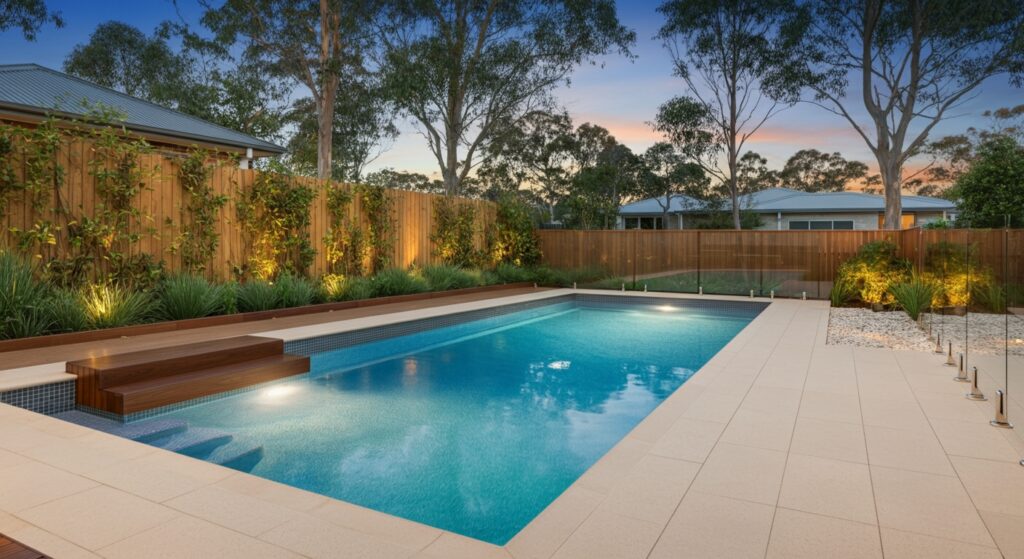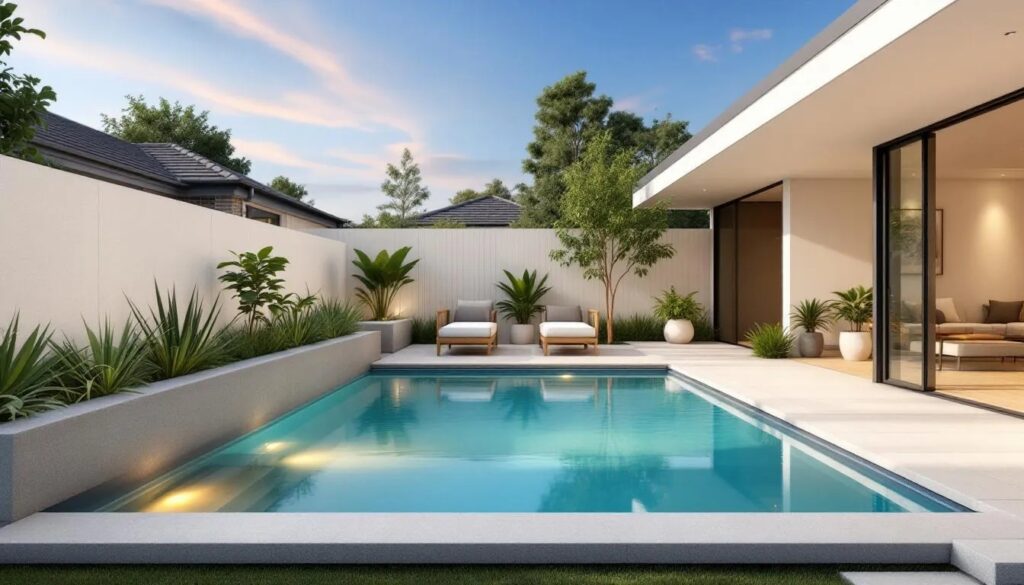In Melbourne, specific suburbs face unique challenges when it comes to wind exposure and natural shade — two factors that can significantly impact pool comfort, water temperature, cleanliness, and maintenance needs.
Coastal areas like Brighton and Sandringham deal with strong winds and salt spray, while hilltop suburbs such as Donvale and Park Orchards experience turbulence and shifting microclimates due to altitude and open landscapes.
This page provides practical guidance for homeowners looking to adapt their pool environment to these local physical realities and ensure year-round enjoyment with reduced upkeep. Is Melbourne’s Climate Suitable for a Pool? Heating, Usage and Design Tips.
Why Wind and Shade Are Bigger Issues in Certain Suburbs
Coastal suburbs: strong coastal winds and salt exposure
In suburbs like Brighton and Sandringham, strong coastal winds are a daily reality. These winds cool pool water quickly, accelerate evaporation, and deposit salt particles that can degrade surfaces and equipment over time. Pools in these areas need thoughtful protection to ensure comfort and longevity. Learn more about heating your pool for year-round use in Melbourne’s eastern suburbs where similar environmental conditions may apply.
Hilltop suburbs: altitude, open lots and turbulence
Donvale, Park Orchards and similar elevated suburbs face constant turbulence due to their topography. Pools on exposed blocks are more vulnerable to heat loss and debris accumulation, making wind mitigation strategies essential for year-round usability and easier maintenance.

How Wind Exposure Affects Pool Comfort and Maintenance
Wind exposure has immediate and noticeable effects on pool use and upkeep. In Melbourne’s coastal and hilltop suburbs, even moderate winds can cool the water significantly, making swimming less comfortable without additional heating.
Debris like leaves, dust, and sand are easily carried into pools by gusts, increasing the need for regular cleaning and straining filtration systems. Wind also accelerates evaporation, leading to greater water loss and higher chemical consumption as owners top up and rebalance their pools more frequently. For insights on how Melbourne’s climate influences pool heating and seasonal use, see our detailed guide.
Practical Wind Protection Solutions for Melbourne’s Exposed Pools
Built structures: fences, screens, glazed barriers
Architectural elements like solid fences, purpose-built screens, and glazed barriers can break the force of prevailing winds around the pool area. In coastal suburbs, materials that resist salt corrosion offer additional long-term value.
Landscaping strategies: hedges, trees, embankments
Dense hedges, well-placed trees, and raised earth features not only provide wind breaks but also integrate seamlessly into the garden’s aesthetics. These solutions are particularly effective in hilltop suburbs where large-scale structural barriers might be impractical.
Wind-aware pool placement on the block
Positioning the pool to take advantage of natural wind shadows, existing structures, or land contours can significantly reduce exposure. Early design choices can eliminate the need for costly retrofits later.

Managing Shade to Maximise Heat and Comfort
Identifying problematic shade sources (trees, buildings, slope)
In Melbourne’s hillier and older suburbs, shade often comes from mature trees, neighbouring buildings, or the slope of the land itself. Identifying these sources early helps in planning pool placement and heating strategies that minimise cold spots and under-heated water. A related strategy is discussed in our page on heating solutions for eastern Melbourne pools.
Balancing UV protection and heat retention
While some shade is essential for swimmer comfort and skin protection, too much can prevent the pool from warming naturally. Striking the right balance — through selective planting or adjustable shade structures — allows homeowners to retain heat without sacrificing safety.
When Wind and Shade Combine: Mitigating Compound Effects
When both wind and shade affect a pool — as often happens in Melbourne’s coastal or hilltop suburbs — the challenges multiply. The cooling effect intensifies, evaporation increases, and debris build-up accelerates. This combination can make pools feel cold, require more cleaning, and drive up heating and chemical costs.
Addressing these compound impacts demands a holistic approach: combining built barriers, strategic planting, and smart pool positioning. Thoughtful design at the planning stage is key to avoiding expensive and less effective retrofits later. Get the complete picture of Melbourne’s pool climate suitability here.
Pools in Melbourne’s coastal and hilltop suburbs face unique environmental challenges, but with the right protective measures, homeowners can extend their swim season and reduce maintenance headaches. A tailored combination of barriers, landscaping, and thoughtful placement helps manage wind exposure and shade effectively.
For a deeper understanding of local wind conditions, refer to Bureau of Meteorology – Wind patterns by Melbourne suburb.
